
Protecting species
Prince Edward Island National Park
PEI National Park's 42 kilometres of breathtaking coastline on the island’s north shore provides important habitat for several species at risk. The sand dunes and beaches, wetlands and forests are home to over 400 species of plants and 300 species of birds and other wildlife.
Some of the species that exist here have population numbers that are threatened for a multitude of reasons. These species have conservation statuses that reflect declining numbers and are identified and monitored by the Committee On the Status of Endangered Wildlife in Canada (COSEWIC) and federally protected by the Species at Risk Act (SARA).
The beaches of PEI National Park are a sanctuary for the endangered Piping Plover which returns every spring for its breeding season, and the coastal ponds are home to the American Eel during a large portion of its life cycle. The dunes offer habitat for a variety of plant and wildlife species, including two plant species at risk: Gulf of St. Lawrence Aster and Beach Pinweed.
Piping Plover (Charadrius melodus)
If you are visiting Prince Edward Island National Park in spring, be aware of Piping Plovers and keep an eye out for these small, sand-coloured endangered birds. Please watch for unprotected nests and report any sightings to Parks Canada staff.

Their Story
The Piping Plover, with its musical call and quick movements, is a lively reminder of our coastline’s fragile beauty. Each spring, this internationally endangered shorebird returns to Prince Edward Island. It nests on sandy beaches and uses gravel and broken seashells to help disguise the location of its eggs. Once hatched, Piping Plover chicks can run and forage for food within just a few hours of hatching!
Watch Plovers in a Dangerous Time to learn how Parks Canada has been working to recover Piping Plover populations in Prince Edward Island National Park.
Threats to These Endangered Birds
The Piping Plover has been designated as endangered or at risk of extinction by the Committee on the Status of Wildlife in Canada (COSEWIC) since 1985. There are many threats to the survival of this ground-nesting bird, including:
- Natural predators, such as foxes, crows and mink
- Severe weather, such as seasonal storms and spring tides
- The presence of people and pets
In addition to the risk of nest destruction, humans and domestic animals can inflict stress by disrupting important feeding regimes necessary for migratory energy stores.
Parks Canada has been working to recover Piping Plover populations in Prince Edward Island National Park since 1982. Parks Canada works closely with partners such Island Nature Trust and the Canadian Wildlife Service to coordinate and maximize recovery efforts as well as to report on the current status of Piping Plover.
Beginning in mid-April, when the birds first arrive, data is collected to identify the numbers and locations of Piping Plovers in PEI National Park. As the season progresses, behavior is observed, nest locations are monitored and we watch closely for signs of hatching, chicks and finally evidence of fledging.
To help mitigate risks to these endangered birds during breeding season, park management issues beach closures in hopes of decreasing disturbance and increasing nest productivity. Additionally,domestic animals (dogs, cats and horses) are also prohibited from beaches in Prince Edward Island National Park from April 1 - October 15 each year is to help minimize disturbance for Piping Plovers and other shorebirds. For more information on closures, please visit: Visitor guidelines.
The number of Piping Plover pairs in the park has been declining over the last 35 years, although trends have been showing an increase in productivity, and breeding pairs have been found in the park since 2012. Even with this increase, Piping Plovers are still below their threshold for the number of breeding pairs and productivity in PEI National Park. Research is ongoing, and Parks Canada continues to work with universities and other agencies to better understand the cause of the decline.
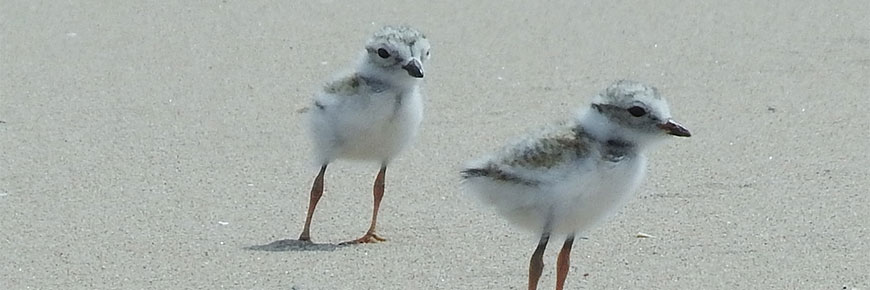
How to Get Involved
It's easy to participate in the Piping Plover recovery effort.
Ensuring an undisturbed nesting area goes a long way to fostering a successful recovery for this species at risk.If you find yourself on a beach where Piping Plovers are nesting you can help by respecting closed areas and by informing others about the Plover and its plight. If you think you may have found an unprotected nest, report it to park staff.
For more information contact PEI National Park at 902-672-6350. By learning more about the Piping Plover and sharing this knowledge with others, you can help protect this endangered species.
American Eel (Anguilla rostrata)
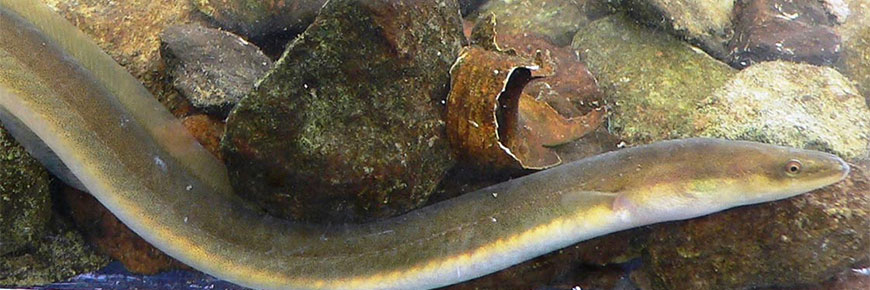
The life of every American Eel begins in the Sargasso Sea. Soon after, the tiny eel larvae drift for months on the currents of the Gulf Stream before finding their way to North America. By the time they reach our shores, they are called glass eels because they are completely transparent. As they gain coloration and become elvers, these long-term visitors make their homes in freshwater areas, including the ponds and streams that flow through PEI National Park. It is here in Atlantic Canada that they become yellow eels and continue to grow for 4 to 25 years before embarking as silver eels on the long trip back to the Sargasso Sea where they spawn and die.
The American Eel is a valuable species to PEI National Park. Unfortunately, there is reason to believe that this incredible lifetime journey of the American Eel may be disrupted by a number of factors, such as habitat loss, dams, overfishing, disease and changing climate patterns.
The American Eel is found in seven national parks in Atlantic Canada. PEI National Park Resource Conservation staff have been monitoring American Eel abundance, and the overall health of their freshwater ponds, since 2006. They have found that the health of the freshwater ponds in PEI National Park is good, and the population of American Eel has been increasing.
While they are not listed under the Species at Risk Act (SARA) as threatened or endangered, the Committee on the Status of Endangered Wildlife in Canada (COSEWIC) has the American Eel listed as a threatened species.
Parks Canada will continue to monitor the American Eel population annually, and do what they can to protect and maintain the freshwater ponds, so that the American Eel, along with the other freshwater fish in PEI National Park, can continue to thrive.
Little Brown Bat (Myotis lucifugus) and Northern Long-eared Bat (Myotis septentrionalis)

Photo credit: Jordi Segers
In many ways, bats are typical mammals: they are warm-blooded, give birth to live young and produce milk. Their ability to fly sets them apart from all other mammals. The Little Brown Bat is a small, mostly brown bat with black ears, wings and a black tail. The Northern Long-eared Bat looks quite similar due to its size and color, but you can tell them apart by looking at their ears. The Northern Long-eared Bat's ears are twice the size of the Little Brown Bat's ears.
The Little Brown Bat and the Northern Long-eared Bat occur in Prince Edward Island National Park. However, their current population status is unknown.
Sometimes a sudden and severe threat can emerge and produce drastic declines such that a species’ very existence in Canada is threatened. In 2011, the government of Nova Scotia requested an emergency assessment of three bat species (including the Little Brown Bat and the Northern Long-eared Bat) because of the discovery of white-nose syndrome, a deadly fungal disease that spreads rapidly in bat colonies that overwinter in caves. The disease has been found in numerous provinces with populations in eastern Canada showing declines of more than 90% in just two years.
Both species are listed under SARA (Species at Risk Act) and COSEWIC (Committee on the Status of Endangered Wildlife in Canada) as endangered. White-nose syndrome is the main reason why we have seen such a significant decrease in the populations of both bat species. Other than white-nose syndrome, threats to both bat populations include:
- Damage or loss of habitat
- Climate change
- Harm or disturbance from humans or wind turbines.
Their populations are small in eastern Canada, but bigger in central and western Canada, and this is because white-nose syndrome hasn’t spread very far west past Ontario.
Parks Canada does acoustic (sound) monitoring from the middle of May to the end of October, at eight different places within PEI National Park. They record, count, and identify each bat call that they pick up on their recording devices, to measure how much bat activity takes place in each location.
From 2016-2017, bat activity has increased in PEI National Park, but this doesn’t directly mean that the number of bats has increased, and unfortunately their exact population status is still unknown. Most of the bat activity was from either the Little Brown Bat or the Northern Long-eared Bat, but it is hard to tell their calls apart because they are very similar.
Parks Canada’s current goal is to keep activity recorded at 2015 levels, or increase if possible. There is limited information on where the Little Brown Bat and Northern Long-eared Bat choose to hibernate over the winter. If these locations are found, Parks Canada will monitor these areas during the bats' hibernation, to see if white-nose syndrome is still present in PEI National Park.
For more information on PEI National Park bat research conducted by the University of Prince Edward Island, please visit: Research and monitoring
Canada Warbler (Wilsonia canadensis)
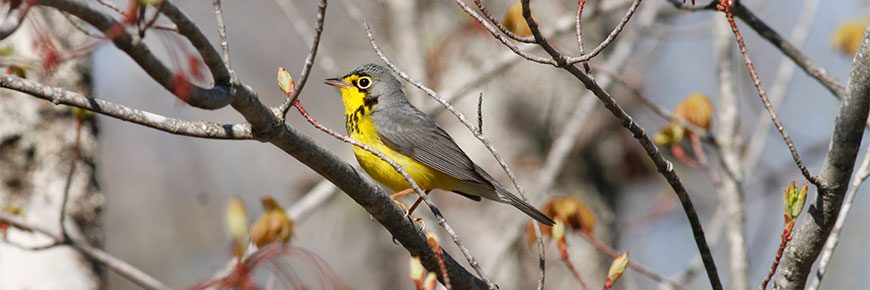
Photo credit: Donna Martin.
The Canada Warbler is a small songbird, easily recognized by its bright yellow belly, and bluish- grey back. They look like they are wearing little necklaces and glasses, because of their grey spotting under their throats, and white rings around their eyes.
They can be found in PEI National Park, in the mixed deciduous and evergreen forests with lots of shrubs during the spring and summer months, before they make their journey down to South America for the winter. They like to build their nests close to the ground, hidden among the shrubs and short plants in forests, so make sure to keep an eye out for them while walking through the PEI National Park trails.
Canada Warbler populations are decreasing quickly, and they are listed as threatened by SARA (Species at Risk Act) and COSEWIC (Committee on the Status of Endangered Wildlife in Canada). It is believed that this is because their forest habitats are being changed into agricultural fields, or the trees are being cut down and used for wood and other resources.
Parks Canada helps this species by protecting and maintaining their habitat, and by conducting surveys during the Canada Warbler breeding season to see how many of these birds use PEI National Park as breeding grounds, and where in the park they like to use. Trees have been planted in Robinsons Island, a breeding location for Canada Warblers, to restore the forest to what it once was. Increasing the health of the forests in PEI National Park will help create optimal habitat for the Canada Warbler.
You can contribute to Parks Canada’s efforts to help the Canada Warbler by staying on the designated trails while hiking, and making sure to properly dispose of any packing from snacks that you may have taken with you for the hike.
Olive-sided Flycatcher (Contopus cooperi)

Photo credit: Dale Murchison
As their name implies, Olive-sided Flycatchers are known for having brownish olive coloring on their sides and upper backs. Their wings are dark with white lines (also called barring), and they have white from their chins to their bellies.
Olive-sided Flycatchers are also known for their distinct three note call, and for perching on top of tall trees in open areas. They choose to sit in these areas because of how they capture their food. They perch on tall branches, and wait for insects to fly by. When they do, they swoop down and catch them, hence the name ‘flycatcher’. They can be found in PEI National Park in tall trees along the edge of a forest, around swamp or wetland areas, or in natural or human made forest clearings.
The Olive-sided Flycatcher is listed as threatened by SARA and COSEWIC, because their numbers have been decreasing in Canada since 1968. It is not known exactly why their populations have been decreasing. It is possibly because of a decrease in their food source, and changes in their habitat.
The amount of human-made forest clearings (from logging) is increasing, which in a way is creating more suitable habitat for the Olive-sided Flycatcher. Even though they choose to live in areas that have been logged by humans, there is evidence that these types of human-changed habitats aren’t as well suited for breeding as natural forest clearings, and we are still seeing a decrease in their population.
Parks Canada is doing what they can by assessing the number of Olive-sided Flycatchers that are present during their breeding season in PEI National Park, and by maintaining and protecting the forest areas that are within the park.
Eastern Wood-pewee (Contopus virens)
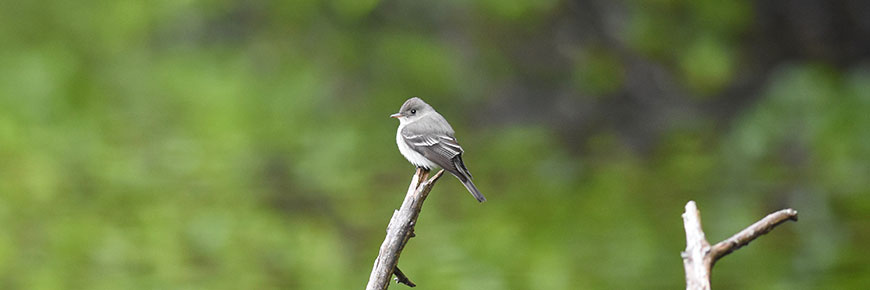
Photo credit: Dale Murchison
Eastern Wood-pewees are often found perching on top of tall trees, similar to the Olive-sided Flycatcher. They do this so they can swoop down and forage for insects flying by.
They have greyish-olive plumage on their backs, and are light on their bellies and throats, with white stripes (barring) on their wings. The Eastern Wood-pewee may be hard to identify, as it looks very similar to other birds. The name comes from its song, which sounds like it is calling “pee-a-wee”!
The Eastern Wood-pewee is listed as a species of special concern, by both COSEWIC (Committee on the Status on Endangered Wildlife in Canada) and SARA (Species at Risk Act). While it is not known for sure what is threatening these birds, it is likely due to changes in their habitat from forestry and agriculture in their summer and wintering grounds, and a decrease in the numbers of insects that they like to eat.
Parks Canada makes sure to keep their forests in the best condition possible, so that this species can thrive. The Eastern Wood-pewee is also monitored during its breeding season to assess how many birds come to PEI National Park each spring, and which areas of the park that they like to use.
Bobolink (Dolichonyx oryzivorus)
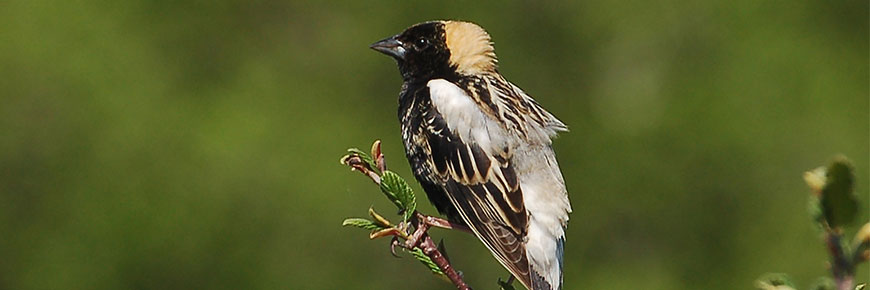
Photo credit: Denis Doucet
The Bobolink is a medium-sized songbird that can be found in PEI National Park. They are easily recognized because of the interesting way that they are coloured. Male Bobolinks are more darkly coloured, with white feathers throughout their wings and with a yellow patch on the back of their heads. The females are primarily light yellow with brown feathering on their heads, upper wings, and backs. They build their nests on the ground in different grassland and agricultural areas.
The Bobolink is listed as a threatened species under the Species at Risk Act (SARA) and the Committee on the Status of Endangered Wildlife in Canada (COSEWIC). Unfortunately, humans have been the reason why the Bobolink population has been decreasing. Since they prefer to build their nests on the ground in cultivated hay fields, their nests are at risk of being accidentally destroyed through farming practices. Pesticide use in fields also causes harm to this species, as well as habitat loss and fragmentation.
Parks Canada keeps track of whether Bobolink populations use the suitable habitat that is found in the federally-owned Crown land that is part of PEI National Park. They are working on exploring ways that they can work with farmers to manage the hay fields of PEI National Park to have less of an effect on Bobolink populations.
Bank Swallow (Riparia riparia)

Photo credit: Dale Murchison
The Bank Swallow was given its name because of where it chooses to make its nest, which is on the side of steep cliff banks. Their nests can be found in natural banks like those found along rivers and coasts of PEI National Park, or in human-made banks, like alongside roadways or in piles of dirt or soil. They are a small songbird, with mostly white on their undersides, and dark grey on their upper sides, with the exception of a dark grey band that covers the bottom of their neck. The conservation status of bank swallows has recently been moved to threatened under the SARA as well as COSEWIC.
Coastal erosion is becoming a more serious problem for PEI’s coastline due to rising sea levels and more frequent storms as a result of climate change. While management techniques like coastal armouring help with the problem of erosion, it leaves Bank Swallows with less space to make their nests, which is a possible reason for their population decline.
When farmers use pesticides, it kills some of the bugs that like to eat their crops. This is good for the farmer, but Bank Swallows are insect eaters, so using more pesticides leaves them with less food to eat. This might also be a reason why less Bank Swallows are seen now than in the past.
Their nesting holes are monitored all along the north shore of PEI National Park by Parks Canada staff, either on foot or by boat. This monitoring is part of the PEI National Park ecological integrity condition monitoring program, completed in late August to early September.
Although the 2016 status of Bank Swallow nesting holes was considered to be in fair condition and stable, there has been a general decline in the number of nesting holes counted along the coast of PEI National Park. Parks Canada continues to do what they can to preserve and protect the north shore coastline.
Barn Swallow (Hirundo rustica)
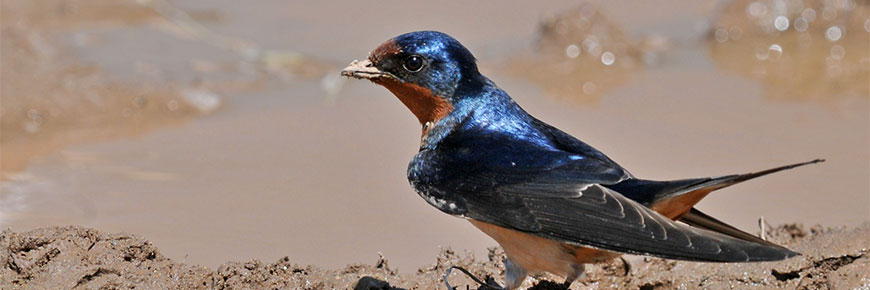
Photo credit: Denis Doucet.
It is common to pass some older looking barns and buildings while driving through rural PEI. Although these barns may not be used by humans anymore, they are important homes to a type of bird: the Barn Swallow. Barn Swallows are medium-sized, colourful songbirds. They have blue feathers on their heads and backs, with rusty orange colouring on the bottom part of their face, and their necks and bellies, with very forked tail feathers. They are most often found nesting in groups, in human-made structures, like old barns or other outdoor buildings, garages or bridges.
Barn Swallows are listed by the Committee on the Status of Endangered Wildlife in Canada (COSEWIC) and the Species at Risk Act (SARA) as a threatened species. This is mostly due to:
- Decreases in insect populations (which are their food)
- Loss of their nesting places when barn owners decide to repurpose or tear down their old barns
- Competition for nesting places with another bird called the House Sparrow (which is an invasive species).
Since Barn Swallows choose to nest primarily in human-made structures, there isn’t a great amount of suitable habitat for them in PEI National Park. Parks Canada ensures that migratory bird species aren’t disrupted before any maintenance or special project work is started, especially during the nesting and breeding seasons.
You can help protect Barn Swallows on PEI by keeping an eye out for nests in your barn, garage, or any other outside building you might own. If you do spot a nest, make sure to give them as much space as possible.
Gulf of St. Lawrence Aster (Symphyotrichum laurentianum)
The Gulf of St. Lawrence Aster is a small annual plant that grows in wet sandy habitat found in dune slacks and along sandy streams. It has been identified at several locations in the park, but because it is an annual and not a perennial, its distribution and abundance vary from year to year.
It grows in low numbers and is found only in the Gulf of St. Lawrence region.
The Gulf of St. Lawrence Aster was recently reintroduced at Blooming Point in PEI National Park. Over 100 plants and seed heads that were grown by biologists at the University of Prince Edward Island were transplanted on the Aster’s preferred and traditional habitat – relatively sheltered sandy areas that experience periodic flooding.
The dynamic and ephemeral nature of the Aster's habitat, coupled with the fact that it is an annual, makes it impossible to predict where the next colony of Gulf of Saint Lawrence Aster may establish. Resource Conservation personnel will continue to search and monitor for this tiny plant in years to come.
Beach Pinweed (Lechea maritima)
Beach Pinweed is a herbaceous perennial plant occurring on large and relatively stable barrier sand dune systems.
Canadian populations of Beach Pinweed are of a variety endemic to the southern Gulf of St. Lawrence and have a very limited geographic range. Only 15 populations in five regions of occurrence are known to exist on New Brunswick’s eastern coast and Prince Edward Island’s north shore.
- Date modified :